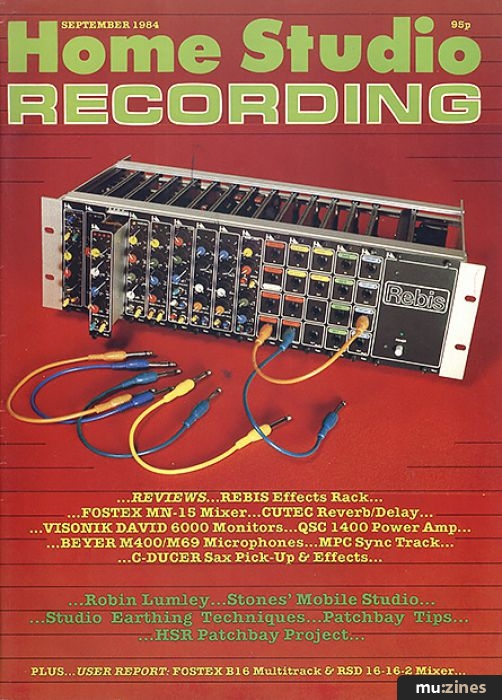Magazine Archive
Home -> Magazines -> Issues -> Articles in this issue -> View
Patchbay Tips | |
Studio Sound TechniquesArticle from Home & Studio Recording, September 1984 | |
Tips on how to make good use of a patchbay.
Alan Cheetham and John Gluck of Audio Services, Stockport outline the benefits a good patchbay can bring to a home studio.

Figure 1.
More and more recordists these days are looking towards a patchbay or jack-field as the answer to their equipment interconnection problems. In this article we will discuss some of the ways this can be achieved, beginning with an explanation of 'Sniff and Break' methods.
Sniff & Break
...Or as they call it in the trade - 'half normalised'. What it really means, as far as home recordists are concerned, is less scrambling around at the back of your mixer and effects (FX) units to connect them all together.
All good quality mixers have a socket at the rear of the mixer channel known as an 'Insert Point'. There are two common types: the 'Jack' type which accepts a stereo jack wired so that the Tip connection carries the Send signal (from the mixer) and the Ring, the Return signal (from FX unit). The second type is the 'Phono With Link' which features a removable metal link in between two phono sockets marked 'Send' and 'Receive' - usually found on Fostex and Tascam equipment.
These insert points offer the facility to connect any type of signal processing unit or FX unit into the mixer channel being utilised. The way one does it without a jackfield (or as some call it - a patchbay), is to connect the channel being utilised directly to the FX unit with a lead. However, this sounds easy, and it is, but what happens when you want to swap this lead over to another mixer channel, or the channel in use to another effects device? You have to waste time unplugging and re-plugging the spaghetti at the back of your mixer.
The simple answer is to get yourself a patchbay and some patch cords. 'Sniff and Break' is the description given to a method of sampling and return routing. You can leave your mixer, recorder and all the effects units connected together at one matrix point (like a telephone exchange). The 'Sniff' socket on the patchbay gives a sample of the sound passing along the mixer channel being used without affecting its routing destination. It can be further described as an output or send which is then introduced to the input of the effects unit via the corresponding socket on the patchbay. The inputs and outputs of all FX devices are merely duplicated on the patchbay.
After selecting the appropriate socket to the FX unit input, our first patch cord has been used (see Figure 1). At this point, our mixer channel is unaffected, but we have a copy of its signal introduced into the input of the FX unit. We then use patch cord II to return the output of the effects device back to the mixer channel and break the chain by introducing it into the 'Break' position on our jack-field channel insert.
An excellent example of jackfield usage is the technique to achieve stereo ADT (Automatic Double Tracking), probably the most frequently used studio trick. For example, if lead guitar is coming into channel 5 of your mixer, you should pan the guitar to the left and route it to a stereo output buss. Connect the 'Sniff' of channel 5 insert to the input of a DDL (Digital Delay Line) and delay this sample by, say, 40 milliseconds and connect its output to a spare mixer channel (number 9, say). Pan this channel to the right and route to stereo. Your guitar sound will suddenly be spread with amazing effect across your monitor speakers.
Finally, Figure 2 gives you some indication of what a comprehensive patchbay layout for an eight track home studio should look like (the mixer envisaged is a 16 input, 8 buss, 8 monitor, 2 master format). The patchbays shown are from State Of The Art and Accessit.

Figure 2.
(Click image for higher resolution version)
For further details on the SOTA and Accessit Patchbays contact: State Of The Art, (Contact Details).
Publisher: Home & Studio Recording - Music Maker Publications (UK), Future Publishing.
The current copyright owner/s of this content may differ from the originally published copyright notice.
More details on copyright ownership...
Feature by Alan Cheetham, John Gluck
Previous article in this issue:
Next article in this issue:
Help Support The Things You Love
mu:zines is the result of thousands of hours of effort, and will require many thousands more going forward to reach our goals of getting all this content online.
If you value this resource, you can support this project - it really helps!
Donations for November 2025
Issues donated this month: 0
New issues that have been donated or scanned for us this month.
Funds donated this month: £0.00
All donations and support are gratefully appreciated - thank you.
Magazines Needed - Can You Help?
Do you have any of these magazine issues?
If so, and you can donate, lend or scan them to help complete our archive, please get in touch via the Contribute page - thanks!




